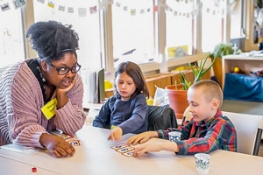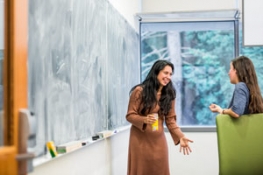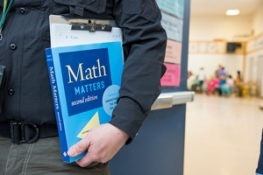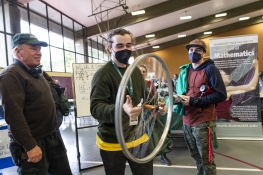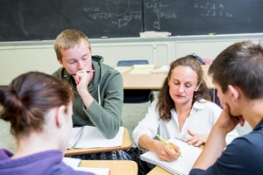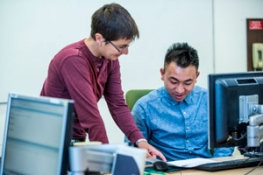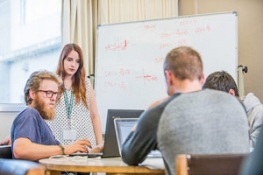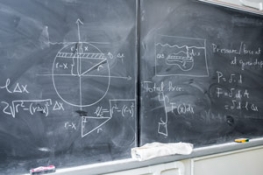Achievements
Publications and achievements submitted by our faculty, staff, and students.
Faculty Kamila Larripa, Anca Radulescu Mathematics
Kamila Larripa and collaborator Anca Radulescu had their paper accepted to the Journal of Theoretical Biology. The paper is titled "A Mathematical Model of Microglia Glucose Metabolism and Lactylation with Positive Feedback" and links cellular metabolism with epigenetic modification. This work was supported by the National Science Foundation.
Student Cheyenne Ty, Amanda Case, Emmanule Mezzulo, Abigail Penland (students) and Kamila Larripa (faculty) Mathematics
Mathematics Cheyenne Ty, Amanda Case, Emmanuel Mezzulo, Abigail Penland, and Kamila Larripa had their research paper published in the Spora: A Journal of Biomathematics. The paper is called "An Agent-Based Model of Microglia and Neuron Interaction: Implications in Neurodegenerative Disease" and explores the role of a type of immune cell in the brain through modeling.
Faculty Kamila Larripa Mathematics
Kamila Larripa and collaborators had their paper accepted to the Springer volume Advances in Data Science. The article is titled "Randomized Iterative Methods for Tensor Regression Under the t-product" and sets forth novel methods to handle multimodal data. This publication is the result of their collaborative work initiated at the Institute for Pure and Applied Mathematics.
Student Cheyenne Ty, Abigail Penland, Kamila Larripa Mathematics
Students Cheyenne Ty and Abigail Fenland presented a research poster at the American Physical Society Far West Conference. The poster summarized their math model of immune cell and neuron interaction in neurodegenerative diseases. They were advised by Kamila Larripa.
Student Cheyenne Ty, Amanda Case, Emmanule Mezzulo, Abigail Penland (students) and Kamila Larripa (faculty) Mathematics
Cheyenne Ty, Amanda Case, Emmanuel Mezzulo, Abigail Penland, and Kamila Larripa had their paper accepted for publication in the Spora: A Journal of Biomathematics. The paper is called "An Agent-Based Model of Microglia and Neuron Interaction: Implications in Neurodegenerative Disease" and explores the role of a type of immune cell in the brain through modeling.
Faculty Chris Dugaw Mathematics
Professor Chris Dugaw updated and published a new edition of the text Laboratories in Mathematical Experimentation: A Bridge to Higher Mathematics, which is used in Cal Poly Humboldt's Mathematical Experimentation and Proof course. This text is composed of a set of sixteen laboratory investigations which allow the student to explore rich and diverse ideas and concepts in mathematics. With the help and support of the original authors at Mt Holyoke and colleagues at University of Texas, El Paso he modernized it to use contemporary computer software. The text is freely available from The Press at Cal Poly Humboldt here.
Faculty Tyler Evans, Alice Fialowski and Yong Yang Mathematics
Dr. Tyler Evans has published a new paper in collaboration with Professor Alice Fialowski (Eötvös Loránd University, Hungary) and her (former) Ph.D. student Professor Yong Yang (Xinjiang University, China). The paper, titled 'On the Cohomology of Restricted Heisenberg Lie Algebras,' appeared in Linear Algebra and its Applications in July, 2024. The authors classify all possible restricted Lie algebra structures on modular Heisenberg Lie algebras and explicitly describe the 1- and 2-restricted cohomology spaces. The full text of the article is available at no cost until September 3, 2024 at https://authors.elsevier.com/c/1jQ~85YnCtZG1.
Faculty Peter Goetz Mathematics
Dr. Peter Goetz gave an invited talk titled "Frobenius Extensions in Noncommutative Invariant Theory" in the AMS Special Session on Homological Techniques in Noncommutative Algebra at the Joint Mathematics Meeting on January 3, 2024. The JMM is one of the largest international meetings of mathematicians with approximately 6000 attendees. Dr. Goetz reported on his new theorem: all dual reflection groups afford examples of (twisted) Frobenius extensions. Dr. Goetz also presented his work on the relationship between Artin-Schelter regular and Artin-Schelter Gorenstein algebras and Frobenius extensions, and examples of Frobenius extensions arising from noncommutative and noncocommutative Hopf algebra actions.
Faculty Kamila Larripa Mathematics
Kamila Larripa was selected to participate in the Simons Laufer Mathematical Sciences Institute's Summer Research in Mathematics Program. She will work with collaborators on developing data-driven modeling approaches to investigate the impact of human behavior on epidemic dynamics for outbreaks such as the COVID-19 pandemic.
Faculty Kamila Larripa Mathematics
Kamila Larripa and collaborators published an article in the Journal of Theoretical Biology entitled Macrophage phenotype transitions in a stochastic gene-regulatory network model. The study classifies cell phenotypes using a spectral clustering algorithm and quantifies transitions between phenotypes using transition path theory.
Faculty Kamila Larripa Mathematics
Kamila Larripa was selected to participate in the Institute for Pure and Applied Mathematics collaborative research workshop in data science. She worked on tensor decomposition methods for machine learning.
Faculty Kamila Larripa, Bori Mazzag Mathematics
Kamila Larripa and Bori Mazzag received a California Learning Lab grant to build critical mass in data science at Cal Poly Humboldt. Project team members include Enoch Hale, Rosanna Overholser and Angela Rich. The grant activities coincide with the launch of a data science major in Fall 2023, and will help move data science into the larger campus community.
Faculty Kamila Larripa Mathematics
Kamila Larripa has been awarded a 3 year National Science Foundation Division of Mathematical Sciences grant for $307,661 to study immune cell activation using multi-scale mathematical models. The project includes collaborating biologists at other institutions and will incorporate and train undergraduate students in interdisciplinary research techniques.
Faculty Dr Peter Goetz Mathematics
Will give a talk titled "Frobenius extensions, Artin-Schelter regular algebras and Azumaya loci" at the Spring Western Sectional Meeting of the American Mathematical Society at CSU, Fresno on Sunday, May 7, 2023. The Azumaya locus of a polynomial identity algebra is an algebraic variety that parametrizes the irreducible modules of maximal dimension. Typically the Azumaya locus is very hard to determine. Dr. Goetz will describe results from his current research project on using Frobenius extensions to compute Azumaya loci.
Faculty Tyler Evans, Alice Fialowski Mathematics
My paper "Central Extensions of Restricted Affine Nilpotent Lie Algebras $n_+A_1^{(1)}(p)$" appeared in the Journal of Lie Theory, 33 (2023), No. 1, 195--215. This paper was written jointly with my colleague Alice Fialowski at Eötvös Loránd Tudományegyetem in Budapest, Hungary during my Spring 2022 sabbatical leave.
Faculty Dr. Peter Goetz, Dr. Andrew Conner Mathematics
Published a paper titled: QUANTUM PROJECTIVE PLANES AS CERTAIN GRADED TWISTED TENSOR PRODUCTS in The Journal of Algebra; https://doi.org/10.1016/j.jalgebra.2022.11.033. The paper is joint with Dr. Andrew Conner at Saint Mary's College of California and will appear in the April 2023 issue. The main results of the paper are: (1) a classification up to algebra isomorphism of quadratic graded twisted tensor products of K[x,y] and K[z], and (2) the determination of which three-dimensional Sklyanin algebras contain a quantum P^1. Sklyanin algebras first arose in the late 20th century in the context of quantum inverse scattering problems in physics.
Faculty Liza Boyle, Sonja Manor, Bori Mazzag Mathematics
Dr. Liza Boyle (Environmental Resources Engineering), Sonja Manor and Dr. Bori Mazzag (Mathematics) presented a workshop entitled "Humboldt Solar Panel Projects". The workshop was held on Feb. 1 in the Mathematical Association of America "Curriculum Renewal Across the First Two Years" workshop series. The workshop showcased course materials developed for Math 109 Calculus I and Math 101T Trigonometry that connect mathematical content to solar energy production. Projects explore local data and discuss broader social implications of the use of solar energy and highlight applications of math to local issues.
Student Viri Macias, Ana Sammel, Emma Villegas, Bori Mazzag, Kamila Larripa Mathematics
Viri Macias, Ana Sammel and Emma Villegas presented their mathematical work at the CSU PUMP Symposium. Viri presented a model for calcium signaling and Ana and Emma presented a model for COVID-19 and immune cell interactions. The projects were mentored by Bori Mazzag and Kamila Larripa.
Faculty Kamila Larripa Mathematics
Kamila Larripa was selected to conduct research at the American Institute of Mathematics in June. She and collaborators will build stochastic models for immune cell dynamics.
Student Bridget Opperman, Kamila Larripa Mathematics
Math student Bridget Opperman will present a research poster on "Mathematical Analysis of Virus-Immune Dynamics and Implications for Treatment" at the National Conferences on Undergraduate Research.

